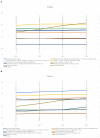Social Engagement and Urban-Rural Disparity in Self-Management Behaviors: Study of Middle-Aged and Older Chinese Hypertension Patients
- PMID: 35155352
- PMCID: PMC8828651
- DOI: 10.3389/fpubh.2021.801307
Social Engagement and Urban-Rural Disparity in Self-Management Behaviors: Study of Middle-Aged and Older Chinese Hypertension Patients
Abstract
Background: This study examines the effect of social engagement on urban-rural disparities in self-management behaviors (medication use, self-monitoring, physical activity, and tobacco and alcohol avoidance) among middle-aged and older Chinese patients with hypertension.
Methods: Data from 2011 to 2018 were extracted from the four latest waves of the China Health and Retirement Longitudinal Study. Chi-square tests and t-tests were performed to examine urban-rural gaps in self-management behaviors. Random-effects panel logit regression models were adopted to confirm the effect of social engagement on urban-rural disparity in self-management behaviors and to explore whether this effect has narrowed or widened with "bilateral flow" between urban and rural residents. A Fairlie decomposition technique was also used to calculate the extent to which social engagement reflects urban-rural disparities.
Results: There was significant urban-rural disparity in medication use and tobacco avoidance behaviors among the sampled patients. Medication use behavior (p < 0.001) among urban middle-aged and older patients was significantly better, whereas tobacco avoidance behavior (p < 0.05) was significantly lower compared with the rural population. Social engagement significantly enlarged the urban-rural gap in tobacco avoidance behavior (p < 0.01), but significantly narrowed the urban-rural gap in medication use behavior (p < 0.001). The Fairlie decomposition revealed that ~75.000% and 29.412% of the explained urban-rural gap in tobacco avoidance and medication use, respectively, could be attributed to social engagement. The negative effect of social engagement on urban-rural disparity in medication use increased when urban residents moved to rural areas (p < 0.05).
Conclusions: The urban-rural disparities in self-management behaviors of middle-aged and older Chinese hypertensive patients were mainly manifested in medication use and tobacco avoidance behaviors. The gaps in these two behaviors partly changed with social engagement, while the migration of urban population to rural areas weakens the positive role of social engagement in narrowing the urban-rural gap in medication use behavior. The insights of this paper on social engagement and urban-rural disparity in self-management behaviors, and the effect of urban-rural migration thereof, deserve the attention of health policymakers and researchers.
Keywords: China; hypertension; self-management behaviors; social engagement; urban/rural.
Copyright © 2022 Lu, Liu, Wang and Zhou.
Conflict of interest statement
The authors declare that the research was conducted in the absence of any commercial or financial relationships that could be construed as a potential conflict of interest.
Figures
Similar articles
-
Urban-rural disparities in hypertension prevalence, detection, and medication use among Chinese Adults from 1993 to 2011.Int J Equity Health. 2017 Mar 14;16(1):50. doi: 10.1186/s12939-017-0545-7. Int J Equity Health. 2017. PMID: 28288635 Free PMC article.
-
Urban-rural disparities in hypertension management among middle-aged and older patients: Results of a 2018 Chinese national study.Chronic Illn. 2023 Sep;19(3):581-590. doi: 10.1177/17423953221102627. Epub 2022 May 22. Chronic Illn. 2023. PMID: 35603631
-
Urban-rural disparities in hypertension prevalence, awareness, treatment, and control among Chinese middle-aged and older adults from 2011 to 2015: a repeated cross-sectional study.BMC Cardiovasc Disord. 2022 Jul 17;22(1):319. doi: 10.1186/s12872-022-02769-5. BMC Cardiovasc Disord. 2022. PMID: 35843959 Free PMC article.
-
A systematic review of measurement tools and senior engagement in urban nature: Health benefits and behavioral patterns analysis.Health Place. 2025 Jan;91:103410. doi: 10.1016/j.healthplace.2024.103410. Epub 2025 Jan 5. Health Place. 2025. PMID: 39761616
-
Bridging the rural-urban gap in access to liver transplantation.Clin Liver Dis (Hoboken). 2024 Jun 12;23(1):e0160. doi: 10.1097/CLD.0000000000000160. eCollection 2024 Jan-Jun. Clin Liver Dis (Hoboken). 2024. PMID: 38872770 Free PMC article. Review. No abstract available.
Cited by
-
Social capital and health consciousness based on regional differences in China: a cross-sectional study.Front Public Health. 2025 Jun 11;13:1598121. doi: 10.3389/fpubh.2025.1598121. eCollection 2025. Front Public Health. 2025. PMID: 40567966 Free PMC article.
-
Association Between Multidimensional Social Participation and Hypertension Among Middle-Aged and Older Adults in China: A Cross-Sectional Analysis From the China Health and Retirement Longitudinal Study.J Clin Hypertens (Greenwich). 2025 May;27(5):e70059. doi: 10.1111/jch.70059. J Clin Hypertens (Greenwich). 2025. PMID: 40326283 Free PMC article.
-
Association between social participation and medical care utilization among rural older adults in China: a longitudinal study based on the CLHLS (2011-2018).BMC Geriatr. 2025 Jun 14;25(1):425. doi: 10.1186/s12877-025-06090-6. BMC Geriatr. 2025. PMID: 40517227 Free PMC article.
-
Peer effects of health behaviors and the moderating role of Internet use among middle-aged and older adults: a nationally representative cross-sectional survey in China.Front Public Health. 2024 Oct 21;12:1405675. doi: 10.3389/fpubh.2024.1405675. eCollection 2024. Front Public Health. 2024. PMID: 39498107 Free PMC article.
-
Urban-rural disparity in risky sexual behavior, HIV knowledge, and healthy practices among men who have sex with men: A cross-sectional study in Southeast China.PLoS One. 2024 Nov 11;19(11):e0312006. doi: 10.1371/journal.pone.0312006. eCollection 2024. PLoS One. 2024. PMID: 39527536 Free PMC article.
References
-
- The General Office of the State Council of the People's Republic of China . China's Medium- and Long-term Plan for Prevention and Treatment of Chronic Diseases (2017-2025). (2017). Available online at: http://www.gov.cn/zhengce/content/2017-02/14/content_5167886.htm (accessed September 1, 2021).
-
- Zhang X, Tan SS, Fierloos I, Zanutto O, Alhambra-Borrás T, Vasiljev V, et al. . Evaluation design of the social engagement framework for addressing the chronic-disease-challenge (SEFAC): a mindfulness-based intervention to promote the self-management of chronic conditions and a healthy lifestyle. BMC Public Health. (2019) 19:664. 10.1186/s12889-019-6979-7 - DOI - PMC - PubMed
Publication types
MeSH terms
LinkOut - more resources
Full Text Sources
Medical
Miscellaneous


